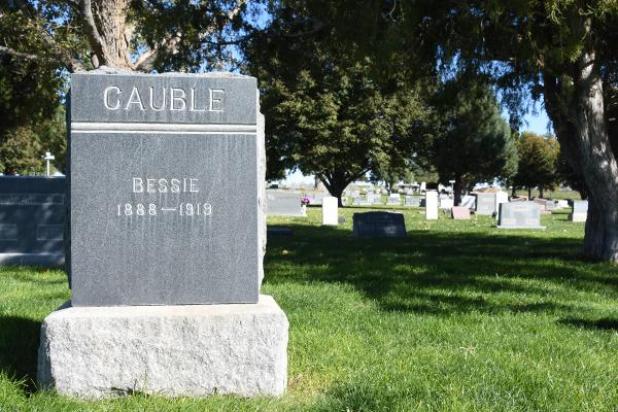
Bessie Cauble is one of the young people who died from the Spanish flu and was buried at Holyoke Cemetery. — Johnson Publications
Mother of all Pandemics
Men, women and children around the globe were preparing celebrations for the end of World War I in the fall of 1918, but meanwhile, a very different kind of battle raged right at home. With 50 million to 100 million deaths worldwide, the Spanish flu of 1918 has been dubbed the greatest medical holocaust in history.
It’s estimated that 500 million people — that’s one-third of the world’s population — were infected with the virus. The 675,000 deaths in the United States alone were enough to make the life expectancy in the U.S. fall by about 12 years, to 36.6 years for men and 42.2 years for women. The flu hit young, previously healthy people especially hard, with an unusually high number of deaths in those ages 20-40 years.
Holyoke was not immune to this widespread flu. The hospital that had just opened in October 1918 was put to good use, and unfortunately, the undertaking business also saw its fair share of victims that succumbed to the Spanish flu from the fall of 1918 to the spring of 1919.
WWI: The enemy at home
What happens when there are 32 countries involved in a world war, with close quarters and massive movement of troops around the globe? It creates the perfect conditions for the international spread of a flu virus.
In the spring of 1918, unusual flu activity was first detected in military camps and cities. However, the news was kept quiet because countries fighting in World War I wanted to keep up public morale and didn’t want to give away vital information to their enemies. This first wave was mild compared to the next two, which hit hardest in the fall of 1918 and the spring of 1919.
The Spanish flu pandemic that spread at an alarming rate was characterized by airborne transmission and symptoms like fatigue, fever, headache, skin discoloration, bleeding and vomiting. Soldiers and populations in wartime countries were already weakened by the stress and poor nutrition of the war.
One hundred years ago, there were no vaccines to protect against the flu, no antiviral drugs to treat the illness and no antibiotics for secondary bacterial infections. Many of the deaths were actually due to pneumonia and tuberculosis that attacked the already weakened lungs.
Doctors and nurses were working day and night to treat the ill, but there was a shortage of available medical staff since so many were serving at military bases in the U.S. and abroad.
Schools, churches and other public places had no choice but to close their doors for a period of time to slow the spread of the pandemic, and some cities even imposed ordinances that required face masks. Armistice Day, Nov. 11, 1918, was a day for celebration, but a day that most likely also fueled the fire of the Spanish flu as cities held public gatherings and soldiers began traveling home.
In the summer of 1919, the pandemic finally subsided, leaving communities to pick up the pieces. Because the flu hit especially hard among young adults, many children were orphaned.
An estimated 500 million people were infected with the Spanish flu around the globe, including 50 million to 100 million deaths. Roughly 675,000 Americans died, and 28 percent of the U.S. population was infected.
Why was it called the Spanish influenza?
As was common during wartime, the countries who were fighting didn’t want news of weaknesses to leak out to their enemies. Spain, however, was a neutral country in WWI, so their newspapers did not have wartime censorship. It was reportedly the first country to announce the pandemic in its newspapers in May 1918. Even the king of Spain, Alfonso XIII, became sick with the flu. The exact origins remain a mystery, but China, France and even Kansas have been suspected.
The full article is available in our e-Edition. Click here to subscribe.
